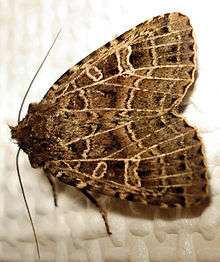Gothic (moth)
| The Gothic | |
|---|---|
 | |
| Scientific classification | |
| Kingdom: | Animalia |
| Phylum: | Arthropoda |
| Class: | Insecta |
| Order: | Lepidoptera |
| Family: | Noctuidae |
| Genus: | Naenia |
| Species: | N. typica |
| Binomial name | |
| Naenia typica (Linnaeus, 1758) | |
The Gothic (Naenia typica) is a moth of the family Noctuidae. It is distributed in temperate Eurasia, in the Palearctic ecozone, including Europe, Turkey, Iran, Caucasus, Armenia, Transcaucasia, Central Asia, Altai mountains, and west and central Siberia.
The forewings are broader than those of most other noctuids, and blackish with a network of fine white lines. The pattern is supposedly reminiscent of some elements of Gothic architecture. The hindwings are grey. The species flies at night in June and July in the British Isles. It sometimes comes to light but is not generally strongly attracted. By contrast, it is strongly attracted to sugar and flowers.
Technical description and variation
This species has a wingspan of 36 to 46 mm. Forewing brownish fuscous, the veins pale;edges of the upper stigmata whitish; the cell blackish; lines pale with dark edges; hindwing brownish fuscous.The form issyca Püng, from Issykkul is redder, and has the termen less crenulate. — brunnea Tutt has the ground colour ochreous brown with the veins pale ochreous instead of white.[1]
Biology
Larva greenish grey, darker dorsally, with subdorsal black patches and a row of indistinct pale oblique streaks along the sides; spiracular line pale, pinkish ochreous, broadly black-edged above; ventral surface yellowish.It is gregarious when young. It is polyphagous, feeding on a wide range of plants, such as burdock, Artemisia, mustards, Buddleja, marigold, chrysanthemum, hawthorn, Cyclamen, silverberry, fireweed, forsythia, hop, lettuce, Lepisanthes, apple, Parthenocissus, plantain, Prunus, pear, rhododendron, willow, spinach, dandelion, coltsfoot, and nettle.[2] This species overwinters as a larva.
Notes
- ↑ Seitz, A. Ed., 1914 Die Großschmetterlinge der Erde, Verlag Alfred Kernen, Stuttgart Band 3: Abt. 1, Die Großschmetterlinge des palaearktischen Faunengebietes, Die palaearktischen eulenartigen Nachtfalter, 1914
- ↑ "Robinson, G. S., et al. 2010. HOSTS - A Database of the World's Lepidopteran Hostplants. Natural History Museum, London.".
References
- Chinery, M. Collins Guide to the Insects of Britain and Western Europe. London: Collins, 1986 (reprinted 1991). ISBN 0-00-219137-7, ISBN 0-00-219170-9.
- Skinner, B. Colour Identification Guide to Moths of the British Isles: (Macrolepidoptera). Harmondsworth: Viking, 1984. ISBN 0-670-80354-5.
External links
-
 Media related to Naenia typica at Wikimedia Commons
Media related to Naenia typica at Wikimedia Commons - Lepiforum
- Funet Taxonomy
- Fauna Europaea